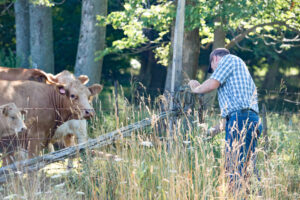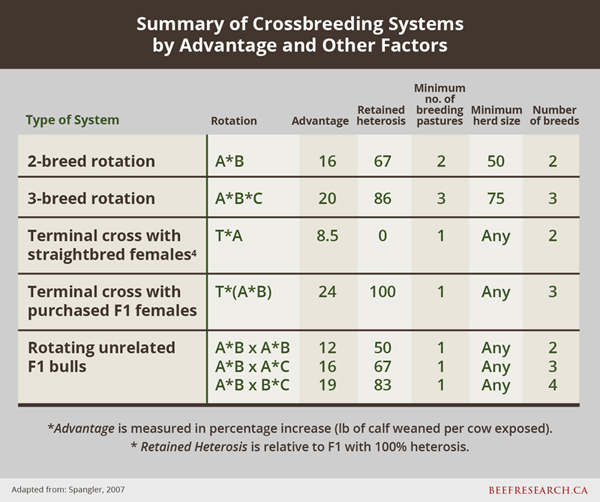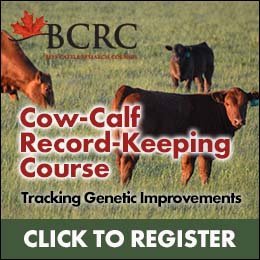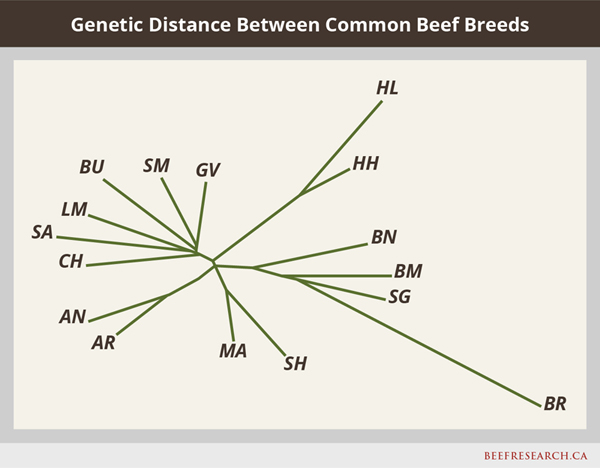This Level 1 record-keeping module is designed for producers that are new to genetics record-keeping or who may already keep records but are unsure of what information is worth keeping or how these records can be used. If you have completed other Level 1 modules, you may have already identified the areas of your operation where you would like to improve and set some production goals. Once you know where you are, you can then start to plan where you would like to go.

Maybe you want your calves to be heavier at weaning? Or you’re interested in more uniform coat colour, so that your calves fit into a certain market? While some of your goals will be influenced by your production practices such as feeding, other goals such as coat colour, will be largely impacted by genetics.
Straight-breeding, using a single breed on your farm, is one method of animal breeding that is easy to manage because you are only using one breed. There are different methods of doing this that are mentioned in the BCRC post, Bull Selection: Breeding Programs that Suit Operational Goals. While straight breeding is easier to manage, it is difficult for one breed to be efficient at everything. There is an advantage to crossbreeding, which is called heterosis or hybrid vigour. Hybrid vigor happens because crossbreeding overcomes the inbreeding depression that occurs in purebred or straight-bred populations and it combines good attributes of two or more different breeds.
If one of your goals is to sell calves at weaning, it would make sense to use a breed such as a Continental or exotic breed, which will maximize direct weaning weights. However, a straight-bred system like this system might maximize outputs but may require large inputs (feed) as well. With that in mind, perhaps it would make more sense from an economic perspective to use a British breed as the genetic base for all dams and use a continental breed for sires. Or, use the existing cow herd and capture added growth in the calves via the sire, which could reduce the input costs from the female side yet still capture added growth in the calves due to the direct growth provided by the sire breed. This is a simple example of a crossbreeding system.10
Why crossbreed?
Studies have shown in crossbred calves7:
- 3% more calves survive to weaning
- 5% greater weaning weight
- 6% greater yearling weight in steers
- 10% of heifers show first estrus earlier than straight-breds
To improve the genetics in your herd, you need to identify your production goals and weigh them against your existing herd. Are you looking to maximize carcass characteristics and could source genetics that result in a terminal cross? Do you want to optimize feeding efficiency? Do you plan on retaining heifers and want to incorporate maternal traits? To improve the hybrid vigour in your herd, one place to start is by identifying which type of breeding system could work best for your operation based on factors such as:
- the management style of the operation
- your production goals
- feed availability
- heifer retention (i.e., terminal versus maternal sires)
- production environment
- number of breeding fields available
- time of marketing
- availability of high-quality bulls
Methods of Specific Breed Crossing
There are several ways in which hybrid vigour can be achieved in a calf crop. The following are a few of the methods where hybrid vigour can be achieved:
Terminal crossing is when females are bred to a sire from a breed known for meat traits known as a terminal sire. This type of cross is used for breeding feeder calves and shouldn’t be used for replacement heifers due to large mature size or excessive muscling. This means you may need to buy all of your replacements or have a separate herd that is bred for replacement females.
Two-way rotation uses two sire breeds (e.g. Simmental and Limousin). The heifer calves are kept and bred to the other sire breed. This system requires two pastures or groups and it is possible to achieve approximately 67% of the maximum amount of heterosis or hybrid vigour.
Three-way rotation uses three breeds, but it works best when these breeds are not strictly maternal or terminal. Part one of the bull selection blog post series provides further information on breeding strategies.
The following table is a summary of the various crossbreeding systems that can be used to achieve hybrid vigour. The type of system that you use will depend on:
- Number of females. You want to ensure you are maximizing resources such the number of females per bull.
- Number of breeding pastures available
- Number of breeds currently within the breeding herd that match the genetic potential of the target market

How can you decide which breeds to use in your breeding system?
The following figure is a good visual of how closely some of the most common beef breeds are related. The different branches show which breeds are most genetically similar. For example, AN and AR represent types of Angus cattle that are all on the same branch. On the opposite side, HL and HH representing Hereford lines are on the same branch. The breeds that some refer to as Continental including Simmental (SM), Limousin (LM), Charolais (CH) and Gelbvieh (GV) are on another large branch. Breeds like Brahman (BR) are well outside the other breeds.
Breed Key: Angus (AN), Hereford (HH), Line 1 Hereford (HL), Red Angus (AR), Shorthorn (SH), Braunvieh (BU), Charolais (CH), Gelbvieh (GV), Limousin (LM), Maine-Anjou (MA), Salers (SA), Simmental (SM), Beefmaster (BM), Brahman (BR), Brangus (BN), and Santa Gertrudis (SG)9.
Data to record:
- Breed(s) of herd sires used each breeding season
- Breed composition of females in the breeding herd
When to record it:
- Record sire breed information at turn out.
- Record the breed information of females at birth or purchase.
Example:
You have decided that you would like to produce a group of calves that will produce a higher weaning weight. Your group of 60 cows is primarily a mix of Angus and Hereford and make the decision to purchase two Limousin bulls that are known for carcass traits (terminal sires). The following year, all of the steer and heifer calves are sold in the fall. This has resulted in a year without producing any replacement females.
For the next breeding season, you decide to purchase an Angus bull to breed what you believe are your 15 best females with the intent to produce daughters from those females as replacements. The two Limousin bulls are then used to breed the remaining 45 females.
Example Goals:
- Select bull(s) of the right breed(s) to achieve goals.
- Improve hybrid vigour in feeder calves by using a terminal sire.
- Identify the breed composition of the breeding herd before next breeding season or bull purchase.
Trade-offs:
As mentioned in the example above, using terminal sires may not produce the optimal traits in replacement females for your operation. This could result in the need for multiple bulls and pastures.
- References
-
- Manglai (2016) Examining Record-Keeping and Benchmarking Effects on the Production and Performance of Cow-calf Farms in Canada.
- Larson, K. (2012). Economics of Cow-calf Production.
- Canfax Research Services (2017). Production & Management Practices that Drive Profitability. Accessed from http://www.canfax.ca/samples/Production%20and%20Management%20Practices%20that%20Drive%20Profitability.pdf
- Focus on Productivity. Canfax Research Services. April 2013. Accessed from http://www.canfax.ca/Samples/Focus%20on%20Productivity%20April%202013.pdf
- Voss, C., Åhlström, P. and Blackmon, K. (1997), “Benchmarking and operational performance: some empirical results“, International Journal of Operations & Production Management, Vol. 17 No. 10, pp. 1046-1058.
- Farm and Dairy (2017) 5 Tips for Setting Farm Goals.
- Alberta Agriculture and Food (2008) The Beef Cow Calf Manual.
- Government of Canada (2019) Keeping Records.
- Kuehn, L. (2011) Predicting breed composition using breed frequencies of 50,000 markers from the US Meat Animal Research Center 2,000 Bull Project. Journal of animal science. 89. 1742-50. 10.2527/jas.2010-3530.
- Spangler, M. (2007) The Value of Heterosis in Cow Herds: Lessons from the Past that Apply to Today. Department of Agriculture and Natural Resources University of Tennessee at Martin.
Feedback
Feedback and questions on the content of this page are welcome. Please e-mail us.
Record-Keeping Version 1.0
Ce contenu a été révisé pour la dernière fois en Janvier 2020.

